What's Food Got to Do with It?
Cookbooks Get back to Their Roots, Fruits, and Roasts
It’s not easy being bacon in the 21st century—or eggs or pasta or parmesan, for that matter. What were once thought to be healthy, wholesome foods in most circles now face all manner of grief from animal-rights activists, gluten and lactose-intolerance specialists, and others who expect more from food than mere sustenance.
Depending on who’s doing the chewing, a fig can be medicinal, spiritual, soulful, sinful, or awful; grapes can be sensual; mangoes, sexy; strawberries, erotic. Pity the sweet little fruits and all that responsibility. No wonder they shrivel and take so well to yeast, fermentation, and the pickling effects of alcohol.
These innovative new cookbooks spotlight island food and Indian cooking; there’s meditation-friendly food and a fascinating tutorial on developing your intuition (with a touch of passive-aggressiveness) in the kitchen. Lastly, you’ll find a refreshed vegan bible.
Spices and Seasons
Simple, Sustainable Indian Flavors
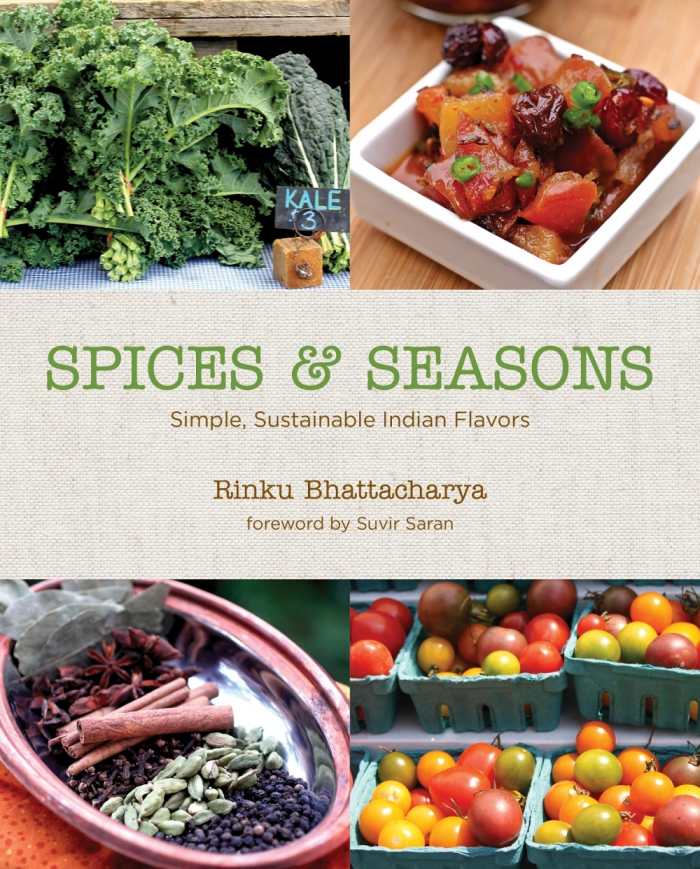
Rinku Bhattacharya
Hippocrene Books
Hardcover $35.00 (370pp)
978-0-7818-1331-0
Buy: Local Bookstore (Bookshop), Amazon
Many accomplished, adventurous cooks live with an irksome blind spot in their culinary repertoire: Indian cooking. Likely, the Indophobes are perfectionist leaning and take issue with the subtle, intuitive, freewheeling nature of Indian cooks and how they prepare and store an enigmatic collection of ground spices in blends, rubs, and pastes and talk lovingly of mothers and grandmothers who nurtured their love of cooking from the ripe age of two.
Intimidating, indeed, but not reason enough to eschew a whole subcontinent of cooking forever—no one’s being forced to open a restaurant in Calcutta. So, if you happen to fall into the fraidycat camp, take a belly breath and seek guidance from a source like the new Spices & Seasons, by the playful, astute Rinku Bhattacharya, a former financial services professional currently living in the Hudson River Valley.
Adamantly committed to playing up the similarities between Indian cooking and more Western culinary sensibilities, Rinku stresses local and seasonal. She simplifies an essential spice kit down to just seven ingredients that form the base of many of the recipes in her book: cilantro, coriander, cumin, red cayenne, garlic, ginger, and turmeric. Then she jumps right in with several easy, enticing appetizers like Radish and Scallion Fritters, Split Pea and Red Onion Crispy Cakes, and delicate salmon kebabs accented with saffron and almond.
Between chapters, Rinku drops in two-page breakouts, offering quick intensives on the Indian approach to working with herbs, alternative and whole spices, souring agents, beans and lentils, stir-frying secrets, and other unique aspects of Indian cuisine. Throughout the book, her recipes come alive with bright vegetables and intriguing combinations: Creamy Mint Chicken Curry, Shrimp in a Mango Basil Sauce, Super Simple Fish Curry, with but ten minutes of prep time. In all, she offers 150 inspired recipes, each accompanied by superb color photographs and warm paragraph-long introductions.
MATT SUTHERLAND (May 27, 2014)
Balinese Food
The Traditional Cuisine and Food Culture of Bali
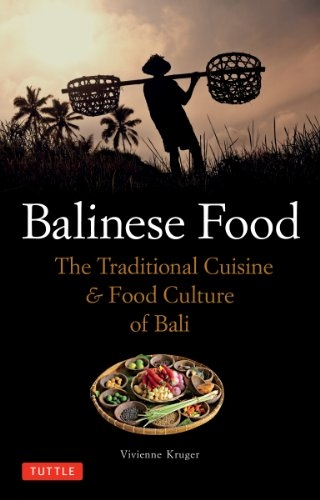
Vivienne Kruger
Tuttle Publishing
Softcover $16.95 (304pp)
978-0-8048-4450-5
Buy: Local Bookstore (Bookshop), Amazon
By way of introduction to Vivienne Kruger’s Balinese Food, bear in mind that eight degrees south of the equator, this modest- sized, lava rich, emerald green island rests among the 17,508 remote, culturally distinct constellation of Indonesian islands. It is home to three million mortals who believe they are protected by an unfathomable number of Bali-Hindu goddesses and gods that inhabit the island’s sacred mountain peaks.
The Balinese are unlike almost any other island people in that they are suspicious, even distrustful, of the sea, believing mischievous spirits and negative powers dwell there—the underworld, as it were. Yes, they eat seafood, they just mostly let other Indonesians do the fetching.
Fittingly, Kruger’s masterful use of language; dogged, on the ground conversations with thousands of Balinese cooks and farmers; and disarming humanity leads to a culinary-minded compendium unlike almost any other. Bali, you got the scribe you deserved.
What makes Kruger’s work even more impressive is the fact that almost nothing about Balinese food history has been written down over the years. She writes: “Like so many other traditions in Bali, cooking techniques and eating habits are passed down verbally by elders to their children and grandchildren who help in the kitchen. However, Indonesia has an old orally transmitted food culture because the pleasure of storytelling is entwined with the pleasure and effort of cooking and eating.”
Balinese Food is framed around twenty-one topics, including the all-important sacred ceremonial cuisine, traditional village foods, the cult of rice, Balinese pig, Balinese duck, and specialized cooking techniques like saté, banana leaf wrappers, and the use of bumbu, a sacred, powerful dry spice paste mixture. In the chapter “Seafood in Bali,” Kruger lists a popular, fragrant accompaniment called sambal matah—chopped shallots, red chilies, coconut oil, and kaffir lime juice—that is always served raw and fresh, in this case, alongside a simple recipe for grilled tuna.
An outstanding achievement in the realm of island cooking and Indonesian history, Balinese Food showcases the Balinese people in the most flattering of ways.
MATT SUTHERLAND (May 27, 2014)
Fresh Cooking
A Year of Recipes from the Garrison Institute Kitchen
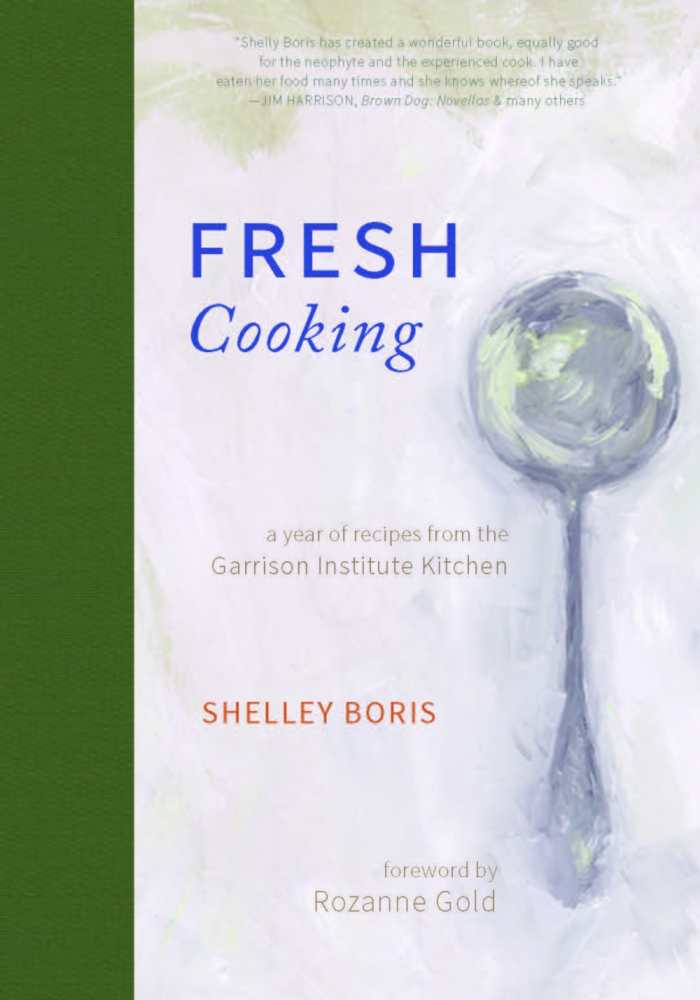
Shelley Boris
Monkfish Books Publishing Company
Hardcover $29.99 (264pp)
978-1-939681-15-7
Buy: Local Bookstore (Bookshop), Amazon
The Garrison Institute, a hugely respected and influential meditation center focused on peace, poverty, the environment, and other troublesome issues of the day, is based in an old Capuchin friary overlooking the Hudson River. Thousands of people a year pass through for a few days or weeks to reflect, wrangle with ideas, or simply be, quietly. And others come for the meals prepared by a humble, sagelike woman named Shelley Boris. The culmination of her ten years at Garrison, Fresh Cooking, Shelley’s new cookbook, is an important achievement in her mind because it has offered her a tangible way to show her appreciation to Garrison and to give something back. The Institute instilled in her a “philosophy that doesn’t dictate answers but asks you to pay attention to what you’re doing.” She advises, “Stay as focused as you can, and when you lose your focus, as we all do, simply start paying attention again.”
So what is meditation-friendly food? “Food that doesn’t try too hard,” she says. Her menus for the month of May feature Polenta with Spinach, Spring Onions, and Parmesan; Black Eyed Peas and Thyme; Spring Vegetable Curry with Brown Cardamom alongside Rice with Sorrel, Garlic Chives, and Mustard Greens; and Whole Roasted Chicken with Green Garlic and Sassafras.
In fact, the monasterial constraints inspire her: “I think of our relatively limited budget as a creative force rather than an impediment.” Consequently, her menus are usually accompanied by cabbage, root vegetables, onions, beans, and grains.
In a foreword, chef Rozanne Gold writes that Fresh Cooking is a worthy heir to the like-minded Chez Panisse Menu Cookbook, Perla Meyers’s The Seasonal Kitchen, and the Moosewood cookbooks: “All game-changers in the way that people connect to food and cooking in a larger context—where taste and ethics are not at odds.”
MATT SUTHERLAND (May 27, 2014)
Jam Today Too
The Revolution Will Not Be Catered
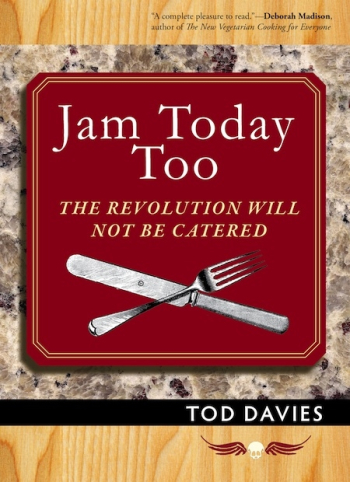
Tod Davies
Exterminating Angel Press
Softcover $15.95 (272pp)
978-1-935259-25-1
Buy: Local Bookstore (Bookshop), Amazon
If you’re looking for a good reason why Tod Davies is an acclaimed cookbook author, look no further than page 60 of Jam Today Too, her latest book, where, in her typical style, she explains what she did with the day old hunk of cabbage she had lying around: “I just shredded what was left and put it on a warm plate. Then I put a serving of roast duck on top of it. A quarter of lime on the plate. And when I finished the duck, I spritzed the lime on top of the cabbage, and ate it as a salad, with the warm duck drippings mixing with the lime in a particularly enticing way.”
Three ingredients, served so stupidly simply, with a big glass of Willamette Pinot Noir … well, yes, Ms. Davies, we get it, and you’ve got a lot of nerve in this golden age of fussy celebrity-chef cookbooks.
Jam Today Too (as well as her first book, Jam Today) is shift-causing in its practicality. Local food denizens and home cooks with above average kitchen skills will relish Davies’s spontaneous, whatever’s-on-hand creativity. “My idea of a triumph,” she writes, “is finding something at the grocery store that is priced cheap because no one else really gets what a great deal it is.” Such as the duck wings she found for ninety-nine cents a pound—a jackpot which led to a splendid handful of pages describing how she tossed the wings, five quartered carrots, and a bunch of peeled garlic into a pyrex baking dish, popped it in the oven for a couple hours while she sipped wine, ate the whole mess in one sitting, dumped all the bones in a soup pot, and made a rich stock. Which led to a Cream of Mushroom Duck Soup, in which she purees the raw mushrooms and onions before adding the simmering broth.
Though some of her recipes are more developed and detailed, the aforementioned is a deadly accurate portrait of what an original voice Davies is. She’s all attitude. Jam Today Too is a treatise on how to develop a sane, honest, joyful relationship with food and cooking (and good red wine).
MATT SUTHERLAND (May 27, 2014)
Vegan Planet
More than 425 Irresistible Recipes with Fantastic Flavors from Home and Around the World
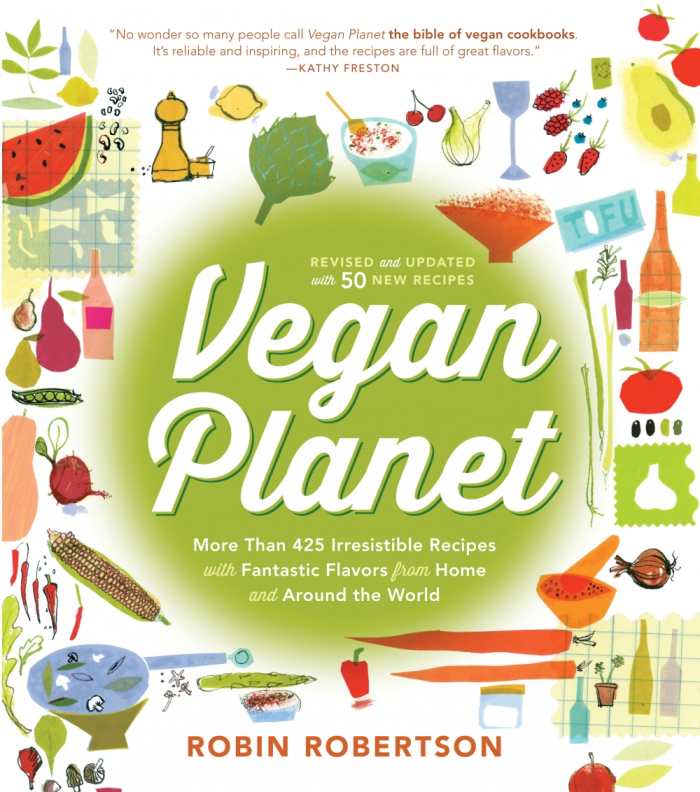
Robin Robertson
The Harvard Common Press
Softcover $19.95 (532pp)
978-1-55832-831-0
Buy: Amazon
This revised edition of the 2007 “bible of vegan cooking” is another monumental testament to the mainstreaming of the animal-free mindset. Millions of Americans now call themselves vegan and are proving that meat and animal products—from soft cheeses to hardboiled eggs and tupelo honey— are not a necessary part of a healthy human diet. We simply, unequivocally don’t require a world with slaughterhouses, industrialized dairy farms, and chicken cages the size of shoe boxes to feed our own species. Better yet, if we took all the land and resources used to grow animal feed and, instead, used it to raise plants for human consumption, the world would be a far healthier, more peaceful place.
But we digress.
Robin Robertson, the author of more than twenty cookbooks, has modernized the original version of Vegan Planet with addendums and additions on newly popular grains and greens (quinoa, kale, chard), health studies, research, and all manner of vegan wisdom. Effortless and entertaining, she drops know-how nuggets on seasoning, cast iron, knife skills, grilling, toasting seeds, roasting chestnuts, sprouts, wasabi, yeast, nondairy milk, antioxidants, and other tips to help the vegan cook.
Most impressively, Vegan Planet is page after page of brilliant ideas: Red Bean Cakes with Creamy Coconut Sauce, Cajun-Style Collards, Springy Tarragon Pasta Salad with White Beans and Roasted Asparagus, Spinach and Tofu Calzones, Artichoke and Wild Mushroom Strudel, Ginger-Scented Vegetable Pot Stickers, and a heavenly dessert chapter featuring Pumpkin- Rum Couscous Cake.
In truth, vegan converts won’t miss or crave anything from their meat-eating days if they’re willing to have some fun in the kitchen. The new vegan can also look forward to taste buds that come alive after a few weeks of eating plants exclusively—food will taste brighter and richer.
Change is rarely easy, but Vegan Planet offers the most surehanded guidance any eager vegan could hope for.
MATT SUTHERLAND (May 27, 2014)
Matt Sutherland
